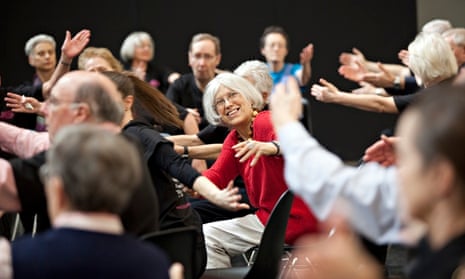Dance is having a moment that’s not about knuckle-headed judging on Strictly, star ballerinas or a cool new choreographer, but about the fascinatingly therapeutic uses to which the art form is increasingly being put. Dancers are being used in the training of doctors, helping them develop skills of empathy and communication, but dance is also being utilised to engage more directly with the patients themselves.
A new film, Capturing Grace, spotlights the work being done at the Mark Morris Dance Center (MMDG) in Brooklyn. Dance for Parkinson’s Disease is a project that started in 2001 when Olie Westheimer, director of the Brooklyn Parkinson Group (BPG), approached Morris about the possibility of the centre leading a programme of serious, rigorous, dance classes for members of her group.
Westheimer knew how valuable the dancers’ expertise in balance, rhythm, control and sequencing might be to those with Parkinson’s disease. Learning to dance might allow them to push against the physical and creative limitations imposed by the disease. Two members of the Mark Morris Dance Group, with a composer and pianist, began giving free monthly classes for the BPG. The sessions have since developed into an extensive programme.
The motor problems that affect people with Parkinson’s disease principally affect voluntary rather than instinctive movements. No one quite knows the science of it, but it seems that something about dancing to music – about imitating a teacher, about developing a muscle memory of dance sequences – seems to temporarily alleviate that problem.
It is not a cure, but while it’s happening it can feel like a liberation. Certainly, as Dave Iverson’s film traces Parkinson’s Dance participants, following them as they train towards a public performance, it shows them gaining confidence and a moving sense of physical freedom.
The success of this programme in transforming lives and expectations has been publicised by the MMDG wherever they appear, and there is now a network of affiliate programmes across the US and in nine countries around the world. In Britain it’s been picked up by English National Ballet, who’ve been running classes at their Kensington base since 2012 as well as operating the scheme at centres in Oxford, Liverpool and elsewhere.
Dancers know about the power of their discipline to combine mind, body and emotion – to create a concentrated, of-the-moment experience – and that’s why dance has also become so useful in the treatment of patients with Alzheimer’s and other forms of dementia. Initiatives like the Centre of Excellence in Movement Dance and Dementia or Circle Dance in Dementia or the American Dance Therapy Association work on the principle that, as individuals lose command of the world they have always known, dance sessions can build a temporary alternative of sound, movement and rhythm. Dance can also introduce a regular experience of physical intimacy and touch, often the things of which patients feel most bereft.
In societies far older than ours, dance was integrated into the daily fabric of people’s lives: in religious dances, war dances, fertility dances, child-birthing dancers, even dances that incorporated the rituals of trading. It is curious that, as we become increasingly hi-tech and ever more in thrall to Big Pharma in our handling of illness, we’re also learning to access and exploit the traditional ways.

